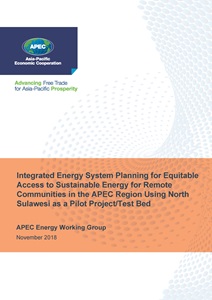Integrated Energy System Planning for Equitable Access to Sustainable Energy for Remote Communities in the APEC Region Using North Sulawesi as a Pilot Project/Test Bed

| Published Date | March 2019 |
|---|---|
| Type of Publication | Reports |
| Publication Under | SOM Steering Committee on Economic and Technical Cooperation (SCE), Energy Working Group (EWG) |
| Accessed | 2635 |
| Pages | 104 |
| Download publication | Download |
Description
This report summarises findings and outcomes of the integrated energy systems modelling. Referring to the recommendations of the Low-Carbon Model Town Stage 5 Final Report for Special Economic Zone (SEZ ) Bitung and the entire North Sulawesi province, the modelling study defines a pathway to lower the system’s emissions while serving demand growth through least-cost capacity additions.
Two base scenarios were considered: (i) Business-As-Usual (BAU) which corresponds to PLN’s Electricity Supply Business Plan 2018-2027 (RUPTL); (ii) Trend Analysis (TA) which reflects historical demand growth over the period 2013 to 2017 and expected demand from the Bitung SEZ. The TA scenario was created to provide comparisons to RUPTL’s growth estimates, which historically tend to have an upward bias. Each of the base scenarios were subject to two levels of energy efficiency intervention, Cost Effective Potential (CEP) and Best-Available-Technology (BAT), reducing demand growth. In total there were six load growth scenarios modelled.
Two base scenarios were considered: (i) Business-As-Usual (BAU) which corresponds to PLN’s Electricity Supply Business Plan 2018-2027 (RUPTL); (ii) Trend Analysis (TA) which reflects historical demand growth over the period 2013 to 2017 and expected demand from the Bitung SEZ. The TA scenario was created to provide comparisons to RUPTL’s growth estimates, which historically tend to have an upward bias. Each of the base scenarios were subject to two levels of energy efficiency intervention, Cost Effective Potential (CEP) and Best-Available-Technology (BAT), reducing demand growth. In total there were six load growth scenarios modelled.

